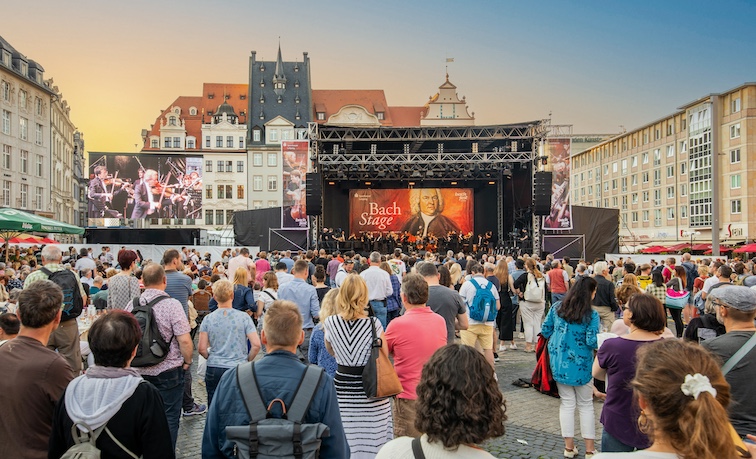
Leipzig hosts the world’s largest annual Bachfest featuring roughly 3,600 musicians. More than 76,000 Bach fans attended BachFest in Leipzig in 2024. Photo by Philipp Kirschner, courtesy of Leipzig Travel.
By Teresa Bitler
If Johann Sebastian Bach could join the tourists and university students in Leipzig, Germany’s City Center today, he’d struggle to recognize the place where he lived from 1723 until his death in 1750. Behind the roofline he likely overlooked from his upper-story home, Panorama Tower shoots skyward. Not far from there, passenger trains roll steadily into Europe’s largest railway station. Even St. Thomas’ Church, where Bach served as cantor for those 27 years, has undergone several renovations since then.
And yet, some familiar sites remain: the Old Town Hall with its baroque tower for one. Then there’s Auerbachs Keller, a restaurant featured in Goethe’s play “Faust.” The centuries-old trade fair exhibition halls that Bach visited often have now been converted into upscale clothing stores and boutiques. Indeed, Bach could still sip coffee at one of the world’s oldest coffeehouses or visit the Leipzig Botanical Garden on the Leipzig University campus.

Auerbachs Keller, which celebrates its 500th anniversary this year, predates Bach’s arrival in Leipzig. Photo by Teresa Bitler.
Then and Now
The combination of old and new hints at Leipzig’s past as a major European merchant city and its downfall when scarred by massive bombing during World War II. Decades of strained resources behind the Iron Curtain meant a prolonged rebuilding process, and even after East Germany’s reunification with its Western counterpart, the city struggled.
Today, Leipzig has finally bounced back to become one of Germany’s fastest-growing cities.
Bach shared a similar fate. Although listeners appreciated his talents during his lifetime, because music then was largely considered one-and-done—played for a specific occasion, such as Sunday service and set aside—Bach’s work slipped from public memory following his death. Only a handful of musicians continued to play his works until another famous Leipzig resident, composer Felix Mendelssohn, sparked the Bach Revival of the 19th century, leading to today’s Bachmania.
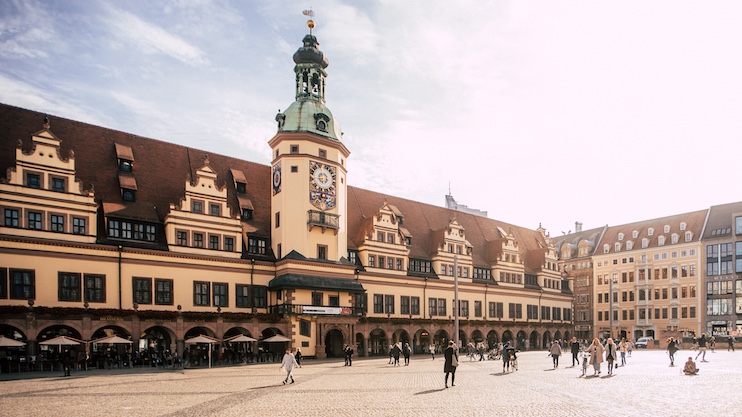
Leipzig’s Old Town Hall (Altes Rathaus) dates back to 1556, about 200 years before Bach arrived in the city. Photo by Tom Thiele, courtesy of Leipzig Travel.
City of Music
Leipzig predates Bach’s arrival by more than 700 years. Founded near the intersection of two medieval trade routes, it received its charter and the rights to host an annual trade fair in 1165, where merchants sold textiles, spices, wine, and other goods. Emperor Maximilian I expanded this to three yearly trade fairs in 1497.
As the trade fairs grew, Leipzig became increasingly rich and culturally influential. In 1409, the city established Leipzig University, whose alumni include writer Johann Wolfgang von Goethe, philosopher Friedrich Nietzsche, astronomer Tycho Brahe and composer Richard Wagner. The university also brought Robert Schumann to Leipzig in 1828 to study law, which he quickly abandoned to pursue a musical career.
Leipzig became a city where people exchanged ideas. As early as 1481, a traveling printer published Leipzig’s first book, and printing soon became a significant industry in the town. Not long after, Martin Luther debated Catholic theologian Johann Eck over the doctrines of free will and grace at Pleissenburg Castle, then located where Leipzig’s New Town Hall stands today.
According to Leipzig Details tour guide Tom Schremmer, the city’s printing industry attracted Luther to the area because its presses could disseminate his ideas. Similarly, composers could take advantage of the presses to print their music when it became fashionable to do so. Schremmer believes the university attracted Bach because his six sons could study there.
Bach in Leipzig
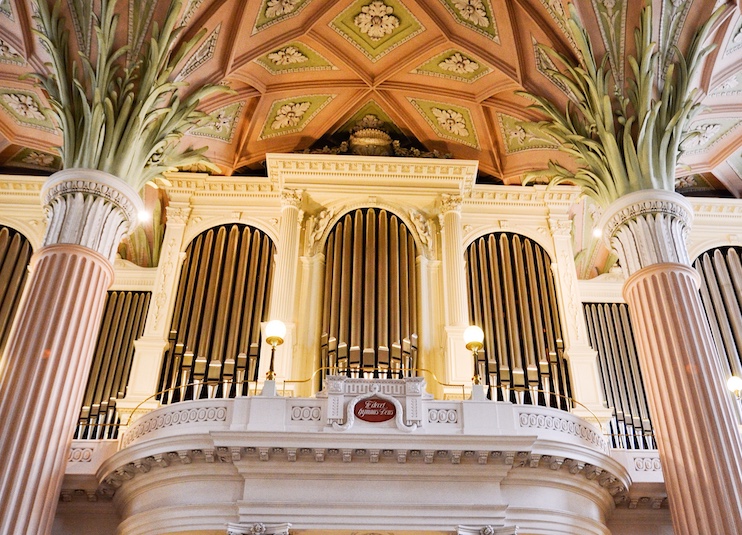
Bach’s compositions were performed at St. Nicholas Church every week on a massive organ with gilded pipes reaching to the ceiling. His personal organ on display at the Bach Museum was much more modest. Photo by Thomas Wolter from Pixabay.
When Bach took the position of cantor at St. Thomas’ Church in Leipzig in 1723, he was already an accomplished organist and harpsichordist, having served as director of music at the courts of Weimar and Köthen. Despite this, the 38-year-old was not the city’s first choice; Philipp Telemann was. Dr. Markus Zepf, a musicologist with the Leipzig Bach Archive, explains that the cantor’s primary job was to teach boys music and Latin at the church’s school.
“Bach wasn’t a trained teacher and, unlike Telemann, had not attended university,” Zepf says. “He was a trained musician.”
Additionally, he didn’t have formal training as a composer. Bach had learned to compose by listening to and dissecting the works of the great composers of the day, such as Vivaldi. Still, he impressed city officials enough to hire him, perhaps because some had seen him play the university church’s new organ a few years prior.
Besides teaching music and Latin, Bach’s duties included writing cantatas to be performed at St. Thomas and St. Nicholas churches every Sunday, with one service held in the morning and the other in the afternoon. Following that, he’d compose the following week’s cantata on Monday and Tuesday so that he could rehearse it with the choir the remainder of the week. When he had time, he taught private students.
As Schremmer gives guided Bach tours in Leipzig, he shares that Bach’s extreme work ethic may have contributed to his death. However, other factors were also at play. Bach may have had diabetes and always suffered from poor eyesight. As his vision continued to deteriorate, he had two unsuccessful surgeries to try to save it. Fever and a stroke following the second of these surgeries caused his death in 1750 at the age of 57.
Rediscovering Bach
Bach’s family buried him in an unmarked grave, as was common at the time, in St. John’s Cemetery. Over the years, people misremembered the exact location of his grave, and Schremmer says the public largely forgot his music.
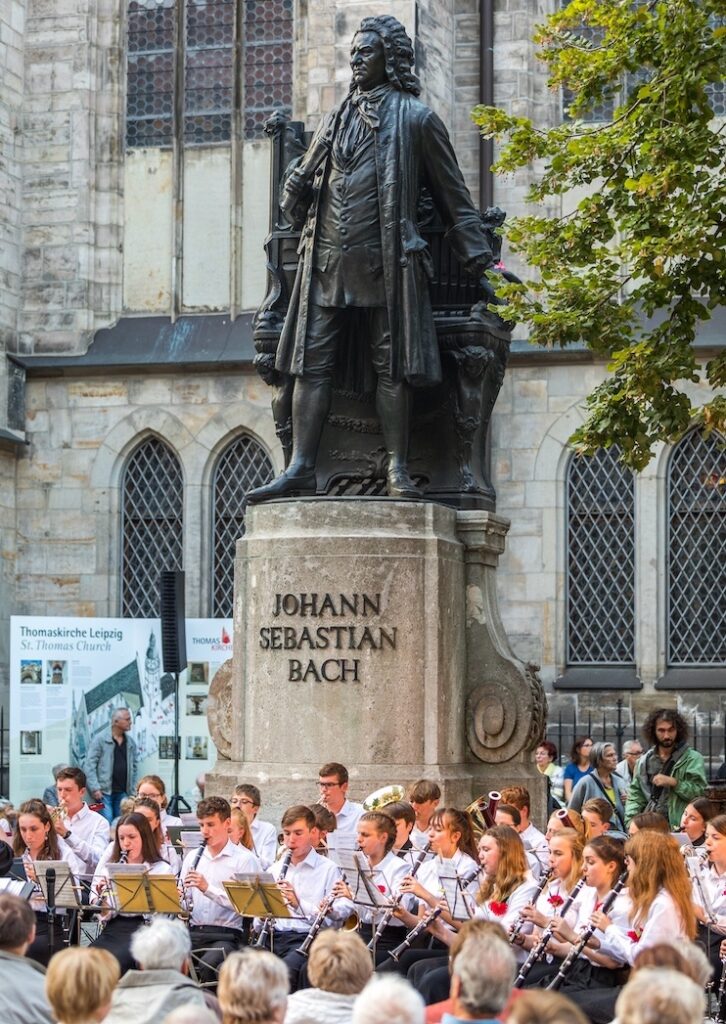
The youth orchestra at St. Thomas Church holds a public recital featuring many of Bach’s original compositions. Photo by Teresa Bitler
Zepf disputes this. He points out that St. Thomas choir has sung Bach’s motets for more than 300 years, and his pupils handed down his works from one generation to the next well into the 19th century. Mendelssohn’s family even collected Bach’s works, which is how Felix became familiar with the St. Matthew Passion.
“The fact that it was no longer performed after 1750 was due to changing tastes,” Zepf explains of the St. Matthew Passion.
He adds that the piece was long and complex, and the poetry of many of Bach’s works had become incomprehensible to listeners even in his own lifetime. Mendelssohn shortened the St. Matthew Passion by half by cutting 10 arias and six chorales while replacing the harpsichord Bach would have used with a piano. When he performed it in 1829, Mendelssohn reintroduced the public to Bach’s genius, kicking off the Bach Revival Movement.
But ironically, just as the public rediscovered his music, history lost his body. Not only could no one remember exactly where he’d been buried, but a Bach biographer in 1874 noted that workers may have moved bodies in that area while making improvements to the cemetery. Still, that didn’t stop F. G. Tranzschel, a pastor there, and others from searching for Bach’s grave in 1894, following the resurgence in his popularity.
Tranzschel had little to go on except that Bach had been buried in an oak coffin without a headstone and in a shallow grave. Workers found three such coffins. One was smashed beyond recognition; another contained a young woman. The third held the remains of an elderly man, which a panel determined to be those of Bach based on height and by comparing a reconstructed face to paintings of the composer.
Convinced this was Bach, Tranzschel had the remains entombed inside St. John’s Church, where they lay until Allied bombs destroyed the church during World War II. City officials then moved Bach’s tomb to St. Thomas Church, where it is now located. Today, modern scientists question whether the man buried there actually is Bach and have suggested performing a DNA test. However, few people in Leipzig want the test completed because if Bach’s remains aren’t in the tomb, no one knows how to find them.
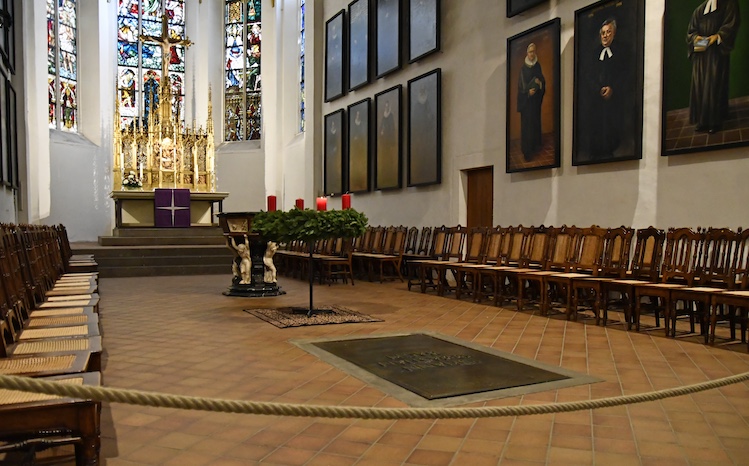
Bach’s grave is located inside St. Thomas Church. Photo by Teresa Bitler.
Leipzig’s dark days
Leipzig experienced a similar rollercoaster fate. Up until the early 20th century, it thrived. In 1650, Timotheus Ritzsche published the world’s first daily newspaper in the city; seven years before Bach’s death, Leipzig formed the world’s first city orchestra. (Before that, only royal courts had orchestras.) Not to mention, the Leipzig Hauptbahnhof, with its 26 platforms, was one of the world’s largest when it opened in 1915. However, the city’s good fortune wouldn’t last.
On December 4, 1943, Allied bombing erased much of what had made the city great for centuries. Rubble covered the downtown, intended to demoralize the citizenry and because it hosted one of Germany’s greatest trade fairs. Further out, factories lay in ruin. Still, Germany fought on for another year. When the war ended, Russia replaced the Nazis, forming a new country, the German Democratic Republic (GDR) in 1948.
Short on resources, Leipzig limped along behind the Iron Curtain for decades. But as the 40th anniversary of the GDR’s creation neared, its citizens began demanding that the country open up so they could travel freely between East and West Germany again. St. Nicholas Church, where Bach once directed the music for the weekly services, spearheaded the movement.
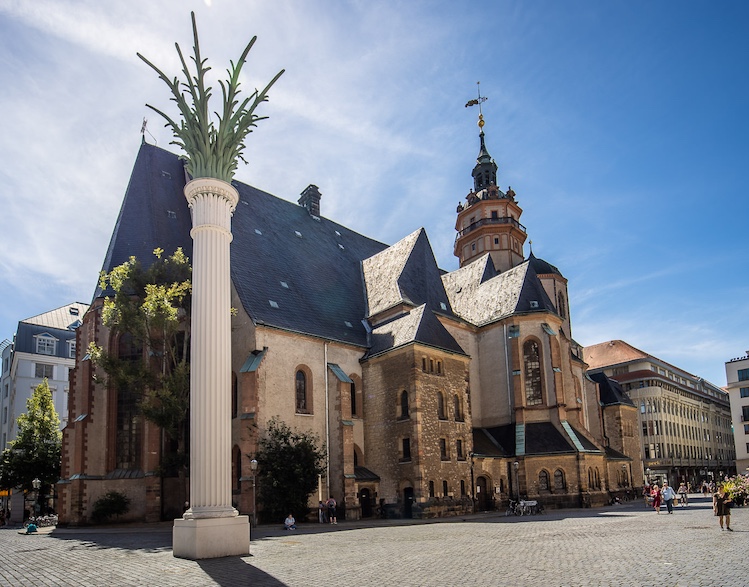
A replica of the columns inside St. Nicholas Church marks where protestors gathered to peacefully march for more freedom on October 6, 1989. Photo by Adam Kumiszcza, courtesy of Leipzig Travel.
Initially, in the early 1980s, parishioners gathered inside the church every Monday at 5 p.m. to pray for reunification. However, by September 1989, attendees began to call for more freedom outside the church as they left. On October 9, 1989, they held the first large, non-violent protest against the GDR government. Other cities followed with demonstrations of their own. The following month, the Berlin Wall came down.
Thriving legacies
Just as Bach made a comeback, Leipzig rebuilt after reunification. Today, it is the fastest-growing city in Germany, set to increase its population by 16 percent between now and 2035, according to city estimates. The main draw is affordability and a strong job market. But new residents also come for the thriving cultural scene.
Old factories, such as the Leipzig Cotton Mill, are now transformed into galleries and studios, and the Gewandhaus Orchestra hosts approximately 800 concerts and events annually. The city is also home to the second-largest book fair in Germany and, naturally, the world’s largest Bach Festival.
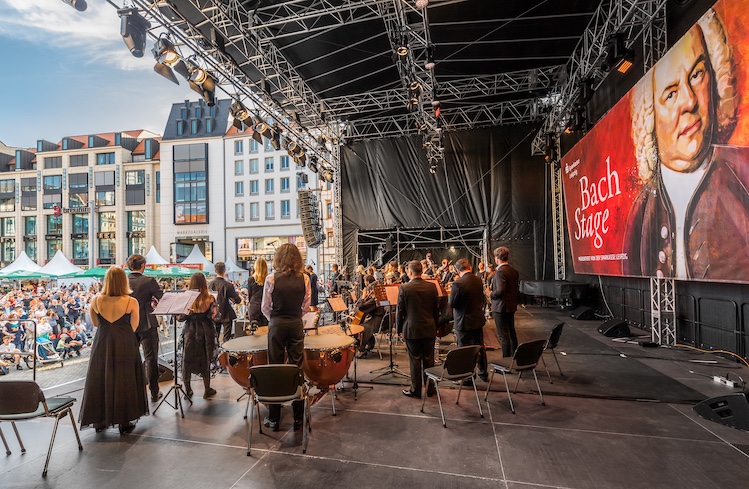
Bach wrote over 300 cantatas while serving as cantor at St. Thomas Church in Leipzig, Germany. Today, more than 76,000 fans of his music attend the annual summer Bachfest in his honor, which will be held this year from June 12 to June 16. Photo of the 2024 Bachfest by Philipp Kirschner, courtesy of Leipzig Travel.
After welcoming more than 76,000 attendees and 3,600 musicians in 2024, this year’s Bachfest Leipzig hopes to set new attendance records. The event, which runs June 12 through 16, takes place throughout the city, from St. Thomas Church to the Auerbachs Keller restaurant and Leipzig Zoo.
Walking the streets of Leipzig today, it’s difficult to imagine the city without Bach. His likeness adorns banners and signs throughout the city center, advertising upcoming concerts or places of interest. But Leipzig isn’t great because of Bach any more than Bach became great because of Leipzig. The two complement each other and, falling by the wayside for a period, they both returned stronger than ever.![]()
Teresa Bitler is an award-winning travel writer who loves exploring culture and history wherever she goes. Her stories for the East-West News Service have looked at America’s bourbon whiskey industry and Spain’s Ibérico ham. She is also the author of four guidebooks.

